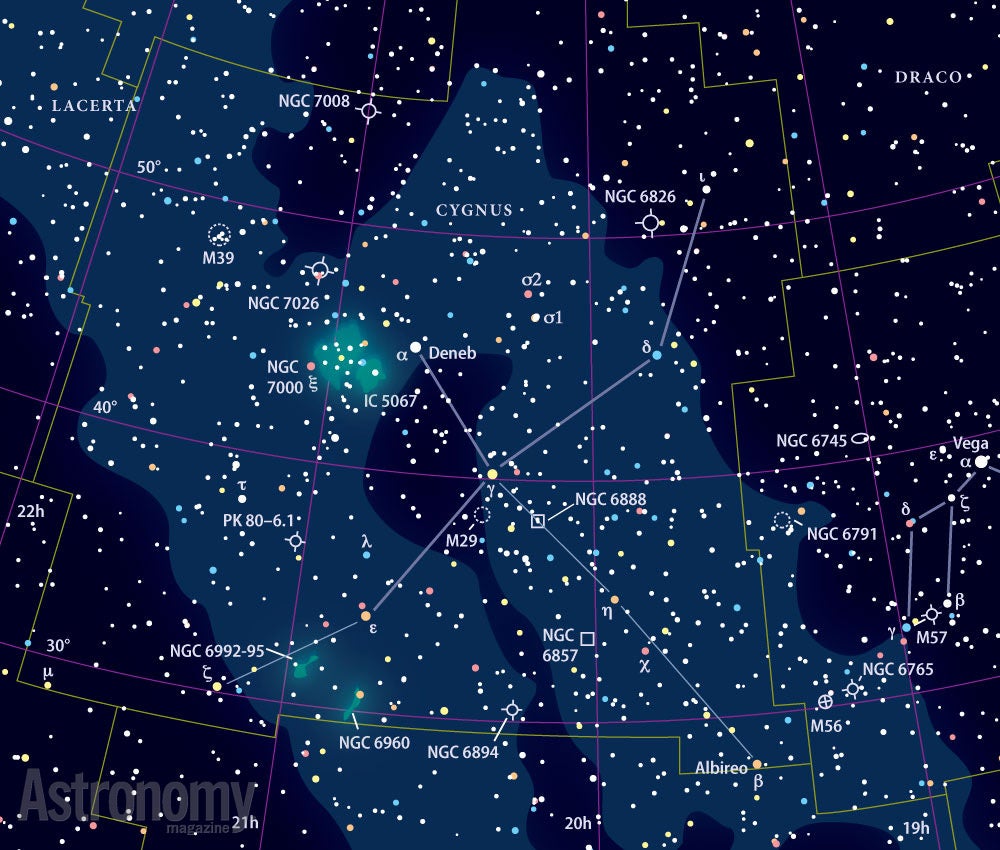Targets for September 11–18, 2014
Binoculars: Herschel’s Garnet Star (Mu [μ] Cephei)
Small telescope: Open cluster M39
Large telescope: Globular cluster Palomar 12
This week’s binocular target is Herschel’s Garnet Star. Astronomers also know it as the variable star Mu (μ) Cephei. But this object isn’t famous because it’s variable. It’s famous because of its color.
Look for Herschel’s Garnet Star almost 5° southeast of Cepheus’ brightest star, magnitude 2.5 Alderamin (Alpha [α] Cephei).
The best approach to seeing the color is to ever-so-slightly defocus your binoculars or a small telescope. The tiny disk you’ll create will then display its copper, ruby, rose, or garnet color. Which is it? That depends on your eye’s color receptors.
That said, Mu’s color won’t be immediately apparent to your unaided eye because it isn’t bright enough to trigger your color receptors. At its brightest, the Garnet Star shines at magnitude 3.4. At its faintest — magnitude 5.1 — most observers still can see the star without optical aid from a dark site.
If you see it at maximum, you’ll have to be patient if you want to see Mu Cephei that bright again. It takes the star approximately 730 days to go through a full cycle, and even that number is variable.
Hidden by stars
My choice for a small-telescope target is open cluster M39 in Cygnus, also known as NGC 7092. You’ll find it 2.8° north of magnitude 4 Rho (ρ) Cygni. M39 shines at magnitude 4.6.
Charles Messier included this open cluster as the 39th entry in his now-famous catalog. But even as a Messier object, I’d rate this object as woefully under-observed by amateur astronomers.
In his classic 19th-century observing guide Cycle of Celestial Objects, Admiral William Smyth described M39 as “a loose cluster, or rather splashy galaxy field of stars, in a very rich vicinity between the Swan’s tail and the Lizard.”
Maybe it’s the large size of M39 — the object covers 31′, an area equal to that of the Full Moon — coupled with the rich Milky Way background star field that makes finding it tough for some observers. Still, look carefully through a 4-inch telescope and you’ll count two dozen stars brighter than 12th magnitude. Use the lowest-power eyepiece you have.
A little-observed cluster
Our large-telescope target is a celestial object from a little-known catalog — globular cluster Palomar 12 in Capricornus. The Palomar catalog of globular clusters contains a scant 15 faint objects discovered on the Palomar Observatory Sky Survey plates.
To find Palomar 12, look 2.8° southeast of magnitude 4.5 Epsilon (ε) Capricorni. This globular lies more than 60,000 light-years away. It measures 2.9′ across and has a magnitude of 11.7.
You’ll need at least an 8-inch telescope to see Palomar 12, and just seeing it is a victory to celebrate. Even through a 20-inch scope, the cluster will appear as only a dim, evenly illuminated “cotton ball.” That’s because the brightest stars in this globular cluster glow at a paltry magnitude 15.
In some catalogs, you might see this object listed as the Capricornus Dwarf. In 1957, Swiss astronomer Fritz Zwicky cataloged it as a nearby dwarf galaxy, a member of the Local Group. That was a mistake. Later, astronomers confirmed its globular cluster status.
Expand your observing at Astronomy.com
StarDome
Check out Astronomy.com’s interactive StarDome to see an accurate map of your sky. This tool will help you locate this week’s targets.
The Sky this Week
Get a daily digest of celestial events coming soon to a sky near you.
Observing Talk
After you listen to the podcast and try to find the objects, be sure to share your observing experience with us by leaving a comment at the blog or in the Reader Forums.











